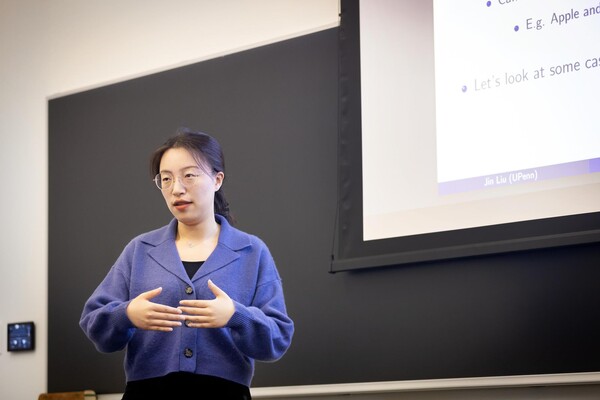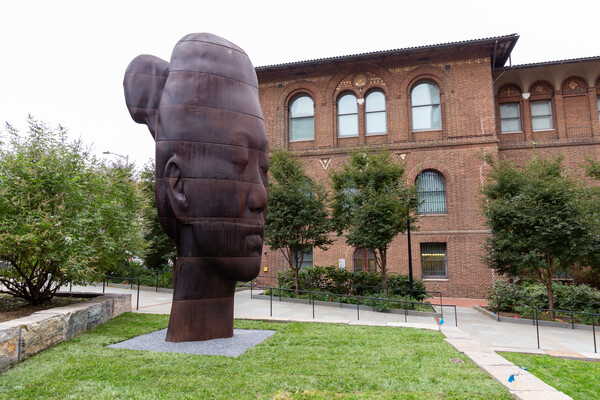
(From left) Doctoral student Hannah Yamagata, research assistant professor Kushol Gupta, and postdoctoral fellow Marshall Padilla holding 3D-printed models of nanoparticles.
(Image: Bella Ciervo)

An entire room at Penn’s Institute of Contemporary Art is covered with three feet of sand that has been carved into a unique landscape by Carl Cheng, who has been a working artist for more than 60 years.
The room-sized sand sculpture is featured as part of “Carl Cheng: Nature Never Loses,” the first in-depth museum survey of his long and varied career. The exhibition is on view through April 6.
“I don’t have a drawing for it. I just get started and then it leads me to the next thing. Whatever I’m doing, it just kind of naturally evolves into something,” Cheng says. “To me you’ve got to just keep open and just intuitively do it. It’s like a performance, even though it is sculpture.”
Based in California, Cheng, 82, has developed a practice that delves into critical topics such as identity, technology, and ecology. He works in myriad materials, from the organic to the industrial.
“Carl is especially amazing because he was creating work about global climate change before the term global warming was even coined,” says Hallie Ringle, ICA interim director, during an opening tour. “And his practice feels so much more resonant today, especially as we collectively grapple with increasing impacts of global warming.”
The curator of the exhibition is Alex Klein, senior curator at the ICA from 2011 to 2022 and now the head curator and director of curatorial affairs at The Contemporary Austin in Texas. She started working with Cheng five years ago to create the exhibition, starting with two-hour video calls once a week during the pandemic. “We worked really closely for Carl to tell his own story, going through his archives, creating a comprehensive approach of how to dive into his work,” Klein says during the tour.
The exhibition was first on view at The Contemporary Austin in the fall and will go to three additional locations after the ICA: Bonnefanten in Maastricht, Netherlands, from May to September; Museum Tinguely in Basel, Switzerland, from December through May 2026; and the Institute of Contemporary Art, Los Angeles, from September 2026 to February 2027.
“Carl’s work not only aligns with ICA’s mission but also elevates it,” Ringle says. “It challenges us to think critically and creatively about the intersections of art, environment, and society.”
The exhibition has six sections, reflecting the six decades of Cheng’s multidimensional practice. The show is funded in part by a $360,000 grant awarded in 2022 by the Pew Center for Arts & Heritage in Philadelphia.
All but six of the artworks, which are on loan, are from Cheng’s personal studio, as he’s not an artist who historically has had institutional or gallery support, Klein says. “The show is very special in that a lot of these things are being shown for the first time since they were made.”
Cheng was born in San Francisco and raised in Los Angeles. He attended the University of California, Los Angeles, earning undergraduate degrees in industrial design and art in 1963 and an MFA in 1967. During a fellowship at the Folkwang School of Art in Germany, he had a post-Bauhaus experience that placed art and design together with dance, theater, and music. Cheng works in photography, plastic, wood, metal, plants, and sand.
“This kind of cross-pollination of art and design is really formative for Carl because everything you see in the exhibition Carl makes himself,” Klein says. “He’s never had studio assistants, and he’s never had outside fabricators, with the exception of the large-scale public artworks.”
The first two works entering the gallery, “Anthropocene Landscape” 1 and 2, from 2006, look like an arial map of a city, but it’s made from pieces of computer circuit boards, transistors, semiconductors, and chips, all with straight lines and hard edges. “Carl has been mapping the ways that capitalism and technology affect the landscape we live in,” Klein says.
The exhibition includes several framings of landscape and images of nature. In a series of works, “Erosion Machines,” boxes made of plexiglass show a constant stream of water on “human rocks” made of organic and inorganic material. “The water starts to reveal the process,” Cheng says.
There is a clear-sided shed in the exhibition that displays avocado pits, “Avocado Laboratory,” created for a 1998 exhibition at the Santa Monica Museum, which continues to evolve to this today. The pits are carved and arranged to create patterns. “I thought this is good material, a byproduct of what I eat, so I started wondering, What can I make of it?” Cheng says, noting that he started working with the seeds around 1970. “I decided that instead of throwing them away, I would do something and leave them out and see where they would erode or weather.”
Klein says that the avocado, a classic California material, represents the area in Cheng’s work that is “counter to the idea of the museum, more of a laboratory with things that are in process.”
Another work that continues to evolve is “Early Warning System” created in 1967. The piece, a commentary on encroachments on the environment, draws on the idea of a beacon for ships, combined with a weather report radio in a natural mountain setting.
The exhibition demonstrates the trajectory, growth, and influence of the forces of nature on his work. There are examples from his first public installation, “Natural Museum of Modern Art,” from 1978 to 1980, installed in the windows of a condemned building along the sidewalk near the Santa Monica Pier. Passersby could insert a quarter, turn a dial, press a button, go under an awning, and look into the window. There was a table of sand and a mechanical metal arm that would go across and wipe the sand smoothly clean, and another stylus would then drop into the sand to make marks in it, different every time.
From that, Cheng started applying to compete for public art projects. In 1988 he created a large-scale sand project, a giant cement roller with shapes that pressed into the sand, creating a changing landscape 12 feet wide for 30 feet. The roller was pulled by a tractor on the public beach between Santa Monica and Malibu in an installation called the “Santa Monica Art Tool.” People could then stomp on the sand. A video wall in the exhibition shows it in action.
“It elicited this kind of wondrous kind of childlike reaction when you get to stomp on a city,” Klein says. “You can also think about the fragility of the built environment and precarity of the human experience. It can all just be washed away.”
The final room in the exhibition, “Human Landscapes,” features a site-specific installation created by Cheng at the ICA. Cheng spent a week carving shapes into the sand using “Art Tool: Rake 924,” also on view. More analog than high-tech, Cheng used a remote switch to make the tool go back and forth; it has an option to drop water and blow lines.
“I just play around until it turns into something,” Cheng says, adding that it’s “kind of a mystery” what will emerge as he works. “What I like about it is there’s no such thing as a mistake, but if I screw up I have to do something to mitigate it because you can’t take anything back from it once it’s done.”
Doing this in five exhibitions “is kind of an odyssey for me,” he says. “Each time, depending on what I’ve been thinking about since the last time, it influences what I do in the next thing.”
Louisa Shepard

(From left) Doctoral student Hannah Yamagata, research assistant professor Kushol Gupta, and postdoctoral fellow Marshall Padilla holding 3D-printed models of nanoparticles.
(Image: Bella Ciervo)

Jin Liu, Penn’s newest economics faculty member, specializes in international trade.
nocred

nocred

nocred